Even on Farms, Bees Look For a Balanced Diet

A study of managed bumble bees and honey bees on a blueberry farm finds that most of the pollen they collect comes from other plants, suggesting that supplementing crops with a diversity of nearby plant types makes for healthier bees. Shown here are honey bee hives near blueberry fields. (Photo by Kelsey Graham, Ph.D.)
By Andrew Porterfield
Managed bees provide a critical service to crop growers, providing pollination as the bees search for nectar and pollen for their own needs. But many crops cannot provide for all the nutritional needs of bees. In those cases, bees begin searching for alternative sources of food.
This means that beekeepers and farmers may need to find ways to provide alternate food sources for their bees—while the bees will still be attracted to crop pollen and nectar, it won’t be an exclusive relationship. But, in turn, the bees will likely be healthier. To find out how managed honey bees (Apis mellifera) and bumble bees (Bombus impatiens) seek out a balanced diet, a group of researchers from Michigan State University looked at pollination and feeding behavior of bees around blueberry crops in that state.
The team, led by Kelsey Graham, Ph.D., a research associate at Michigan State’s Entomology Department at the time of the study and now at the U.S. Department of Agriculture’s Agricultural Research Service, determined what plants managed honey bees and bumble bees visited during high bush blueberry pollination season. They found that the most pollen collected was from plants other than blueberries, even though the blueberry bushes were the most abundant resources during the study. They also found that honey bee and bumble bee collection behavior varied a lot. Their results were published in July in Environmental Entomology.
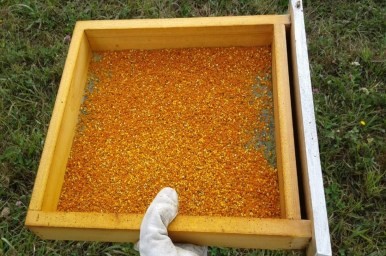
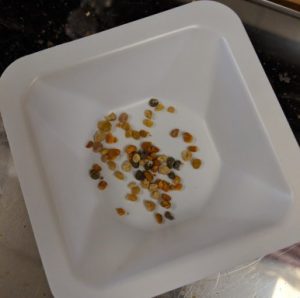
In 2018 and 2019, the team collected pollen from bee colonies at 14 blueberry farms in Michigan. At each field, they used a 10-frame pollen trap immediately before the start of blueberry blooming (in early or mid-May) and collected samples through the end of the bloom (early to mid-June). At the same time, the researchers placed bumble bee colonies at the margin of each site, far enough away from the honey bee colonies to prevent raiding and robbing. The team used microscopes to identify the plant sources of the pollen.
Perhaps typical for them, bumble bees collected pollen from a wider range of plant species than did honey bees. Honey bees collected 21 pollen types in both 2018 and 2019. Bumble bees, however, collected 29 types in 2018 and 52 pollen types in 2019.
Surprisingly, common buckthorn (Rhamnus cathartica), an invasive species native to Europe and Asia, was one of the most abundant pollens collected by both types of bees. Willow (Salix spp.) was another. “Collection is likely from an invasive species in this area of Michigan, though there are some native species they could be visiting,” says Graham. “I think it surprises people to find out that blueberry pollen was not a dominant pollen collected by honey bees. While honey bees still provide pollination services for this crop through some pollen collection and nectar visits, it’s not a preferred pollen type.”
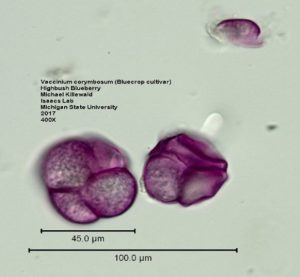
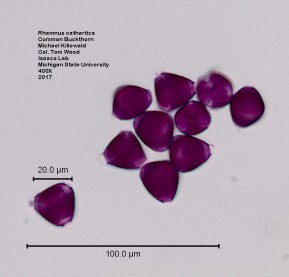
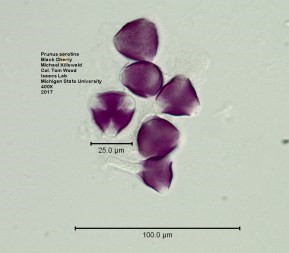 Although blueberry is a pollen-dependent crop that relies on managed and wild bees to yield fruit, blueberry pollen is not particularly nutritious for bees. Pollen provides proteins, fats, sterols, and micronutrients to support adult bee and brood health. However, the protein content of blueberry pollen is 13.9 percent, too low to sustain a healthy honey bee colony.
Although blueberry is a pollen-dependent crop that relies on managed and wild bees to yield fruit, blueberry pollen is not particularly nutritious for bees. Pollen provides proteins, fats, sterols, and micronutrients to support adult bee and brood health. However, the protein content of blueberry pollen is 13.9 percent, too low to sustain a healthy honey bee colony.
Therefore, bees will forage for other nutritional resources. Meanwhile, other studies have shown that a diversity of pollinators can improve pollination services for plants.
Graham and her team also studied whether landscape diversity influenced foraging behavior, but it appeared to have no effect on the diversity of pollen the bees collected. In other words, bees sought out a multitude of pollen types, even if they had to go further to find it. “This definitely suggests that honey bees and bumble bees are making foraging decisions based on floral characteristics and nutrition rather than just what they come across in the landscape,” Graham says.
The potential downside, though, to a predominantly crop landscape is that, as at least one other study has shown, the additional energy expended to collect pollen from other plants may reduce brood production.
“It’s somewhat rare that a single pollen source can fulfill all macro and micro nutritional requirements,” Graham says. “So, in landscapes where the crop is the primary plant available, supplemental plants through pollinator plantings or preserving natural habitats near farms can provide a large benefit to bees.”
We are here to share current happenings in the bee industry. Bee Culture gathers and shares articles published by outside sources. For more information about this specific article, please visit the original publish source: Even on Farms, Bees Look For a Balanced Diet (entomologytoday.org)








